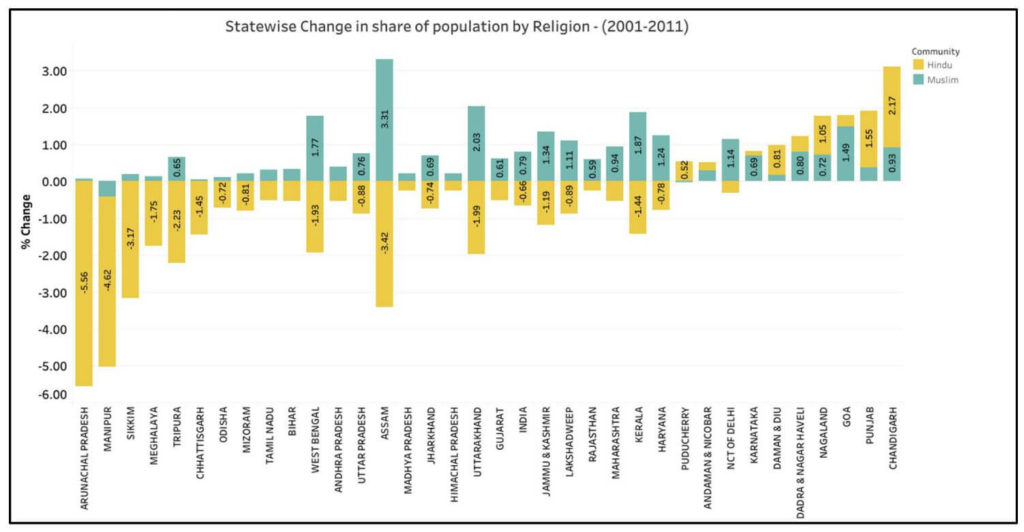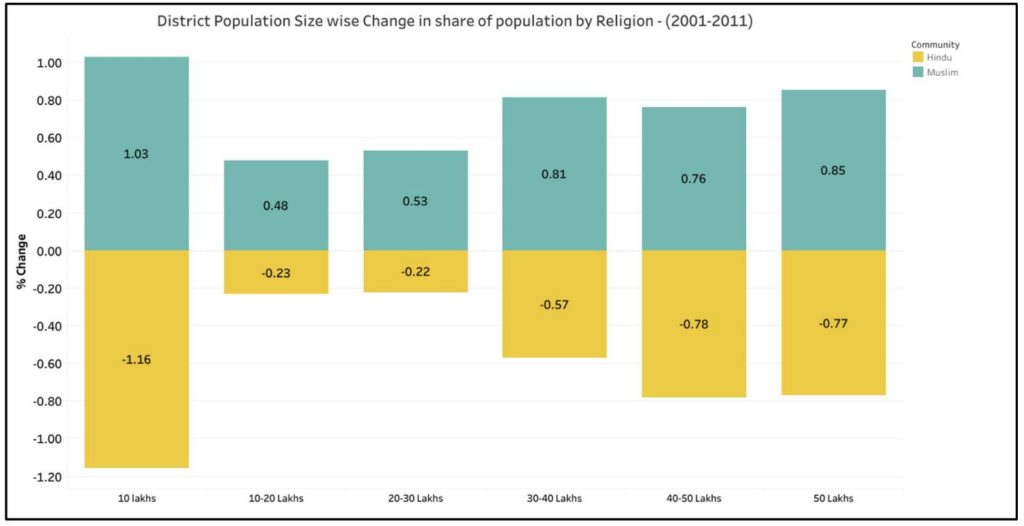[orc]There is a perception that the Muslim population has grown exponentially resulting in a significant change in the share of Hindu & Muslim population across the country. What do the numbers say?
India’s population growth rate has shown a declining trend over the past few decades as noted in one of Factly’s earlier stories. However, data also reveals that the population growth rates are not even across the country. The Hindi speaking states of North India have a population growth rate more than that of India, while the southern states perform better with lower rate of population growth.
An earlier review of the highly populated districts in India, showed that many of these districts are urban districts and the increase in their population over the decade (2001-2011) is largely due to the migration into the major urban centers.
At the same time, it is also true that the population growth rate in India is different for different religious communities. We explore this in this story, especially with respect to Hinduism and Islam, which happen to be the largest religious communities in India.
Marginal increase in share of Muslim population across the states
As per the 2001 census, the share of Hindu population in India was 80.4% while by 2011 it decreased marginally to 79.8%. The share of Muslim population in 2001 was 13.4% while it increased to 14.2% by 2011. The share of other religions in the population of India is significantly lower, with Christianity, the larger of the other religions accounting for 2.34% of the population in 2001 and 2.30% as per 2011 census.
The change in the share of population for both Hindu and Muslim communities in India has been marginal across the states. The share of Hindu population dropped by 0.65% whereas the share of Muslim population has increased by 0.8%.
The share of Hindu population within the states has marginally declined across the states while Muslim population share has registered a marginal increase across multiple states during the 2001-11 period. This reflects the marginal decrease and increase of Hindu and Muslim population share respectively at the national level.

The Union territories and states including Nagaland and Punjab have a positive growth in share of Hindu population. However, the Hindu community in these states is a minority and hence the base figures are less. The majority community is Christian and Sikh respectively in these states.
Assam, West Bengal, Chhattisgarh and Kerala are the larger states which has seen a decrease in share of Hindu population by more than 1%. The decrease in the share of Hindu population was less than 1% in the other big states. In Assam, the share of Muslims increased by around 3.31% whereas the share of Hindus decreased by 3.42%. In the case of West Bengal, the share of Hindu population decreased by 1.93% while the Muslim population share increased by 1.77% during 2001-11.
The Muslim population growth rate is more than the Hindu population across most of the states. Assam, Uttarakhand, West Bengal, Kerala, J&K, Haryana and Delhi are among the larger states where the share of Muslim population increased by more than 1%. Assam recorded the highest change with increase by 3.31% followed by Uttarakhand with 2.03%.
What about change in share in Districts?
Out of the 593 districts as per 2001 census (new districts of 2011 census are consolidated into the older districts for better comparison), 20 districts have a population of over 50 Lakhs as noted in one of Factly’s earlier stories.
The share on Hindu population in these 20 districts has gone down by 0.77%. It was 79.26% in 2001 and is 78.49% as per 2011 census. Correspondingly, the share of Muslim population has grown from 17% to 17.85 % i.e. an increase by 0.85% during the same period in these 20 districts.
Further, there are 35 districts which have population between 40-50 Lakhs. The share of Hindu population in these districts during 2001 census was 81.47% which fell by 0.78% to 80.69% in 2011.

The share of Muslim population in these districts increased by 0.76% from 16.2% in 2001 to 16.96% in 2011. The fall in Hindu population share is comparatively lower in the districts with 30-40 lakh population with a decrease of 0.57%. On other hand, the increase in Muslim population for these districts is 0.81%.
The overall share of Hindu population in all these highly populated districts (more than 30 Lakhs) as per 2011 census is 79.26% and that of Muslim population is 16.73% there by impacting the overall change in the share of population at national level. This also means that the Muslim population is concentrated in highly populated districts.
The change in share of Hindu Population in districts with population of 20-30 lakhs and 10-20 lakhs is the least among the population size groups with a reduction of 0.22% and 0.23% respectively. The increase in Muslim population share is also the least with 0.53% and 0.48% respectively in these two population groups. A total of 307 districts i.e., more than half of the total districts fall under these two population size groups. The share of Muslim population in these districts is only 11.98% which is less than the national share of 14.2%.
Larger variance in the population is observed in the group of districts with less than 10 Lakhs population (there are 157 districts). Hindu population share has decreased by 1.16% in these districts while the share of Muslim population increased by 1.03% during 2001-11.
Districts with extreme population share change distributed across various population sizes.
A total of 192 districts of the 593 have witnessed a change in the share of Hindu population by more than 1%. Of these, share of Hindu population in 150 districts reduced by more than 1% in the 2001-11 period. In the rest of 42 districts, the share of Hindu population increase by more than 1%. Around 110 of the 150 districts with fall in population share of Hindus by more than 1% are those with a population of less than 30 lakhs.
In 16 out of the 24 districts in Assam, the share of Hindu population decreased by more than 2%. In Nalabri and Barpeta districts of Assam, both with population of more than 10 lakhs, the share of Hindu population decreased by a whopping 12.39% and 11.05% respectively, while the Muslim population in these districts has increased by 13.87% and 11.37% respectively. In Nagaon and Kamprup districts of Assam with more than 23 lakh population, the share of Hindu population has reduced by 4.41% and 2.7% respectively while the share of Muslim population increased by 4.37% and 2.39% respectively in the 2001-11 period.
South Twenty-Four Paraganas and Murshidabad districts of West Bengal, with population of 69 Lakhs and 58 Lakhs respectively, have seen a drop in the share of Hindu population by 2.69% and 2.71% respectively. The share of Muslim population in these districts grew by 2.33% and 2.6%.
Ranchi with population of 27 Lakhs has a seen an increase in the share of Hindu population by 5% and even Muslim population share in this district has increased by 1.57%. Ranchi has seen a decline in Christian population during 2001-11. The share of Hindu population increased by 3.21% in Ludhiana district of Punjab that has 30 lakh population as per 2011 census.
The share of Muslim population changed by more than 1% in only 98 districts out of 593 districts. Of these, the share increased by more than 1% in 89 districts while it decreased in the rest of districts.
Of the districts with more than 30 lakhs population, Muzaffarnagar (3.22%), Saharanpur (2.84%), Murshidabad (2.6%), Uttar Dinajpur (2.56%), South Twenty-Four Paraganas (2.33%), Hyderabad (2.28%) and Aligarh (2.07%) have registered the highest increase in the share of Muslim population between 2001-11.
Is there an exponential growth in the share of Muslim population?
The increase in the share of Muslim population across the country was less than 1% i.e. 0.8% over a decade. Considering that the overall share of Muslim population is only 14.2% in comparison to Hindu population (79.8%), the growth in the share of Muslim population is marginal contrary to the perception of exponential growth in Muslim Population. However, as noted earlier, in certain districts of the country, the share of Muslim population has grown exponentially.
Featured Image: Hindu & Muslim population


